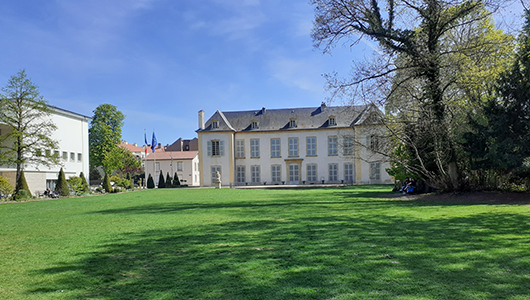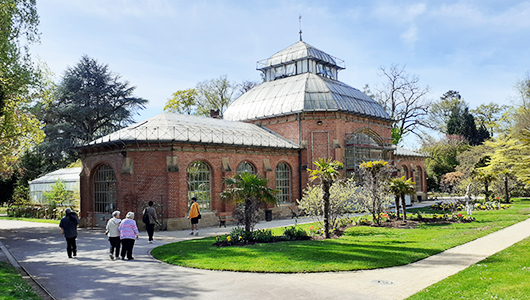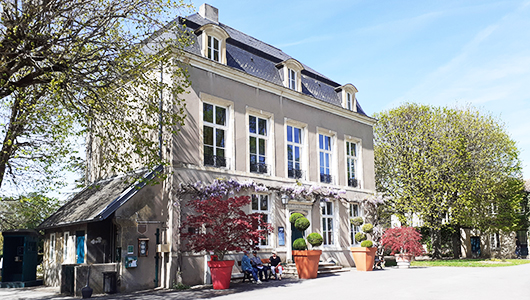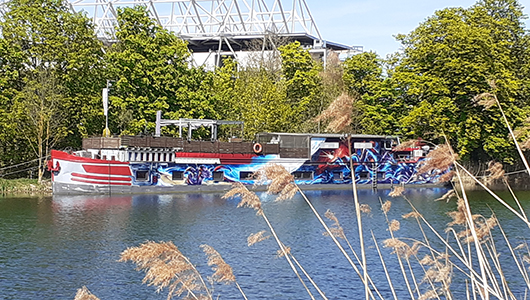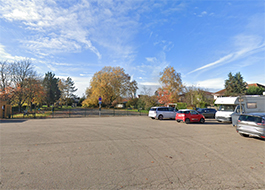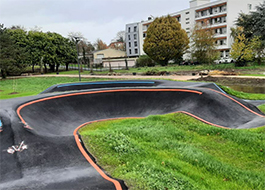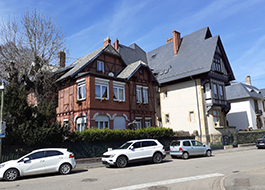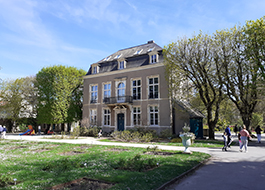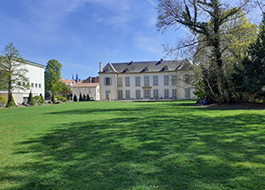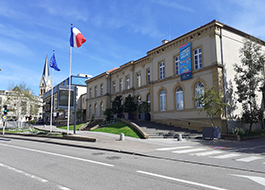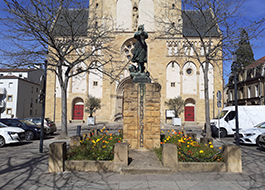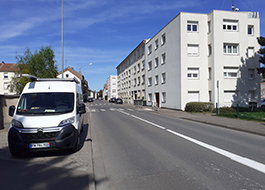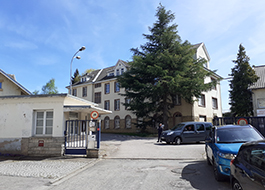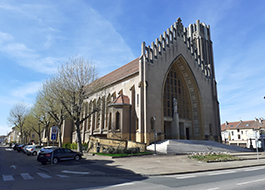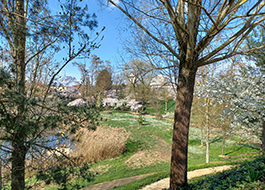Montigny-lès-Metz – La ville
Durée visite : 240 minutes
Moyen : Pédestre
En 1404, Montigny-lès-Metz compte uniquement 2 maisons de métayers. Montigny est une vouerie épiscopale jusqu’à la Révolution ; elle est gérée par les seigneurs de Varize. Les Templiers possèdent également des biens à Montigny. La seigneurie appartient au XVe siècle à la famille patricienne messine de Heu, puis au XVIIIe siècle à l’abbaye de Saint-Antoine-de-Padoue. Par la suite, après l’annexion du pays messin par la France (1552), Montigny fait partie de la province des Trois-Évêchés. Cette même année, lors du siège de Metz, Charles Quint souffrant d’une crise de goutte trouve un logis à la tour de la Horgne, ferme-château, possession de l’abbaye Saint-Clément de Metz. En 1817, Montigny-lès-Metz est un village de 848 habitants répartis dans 108 maisons. Il a pour annexes le village de Saint-Privat, le hameau de la Basse-Montigny, les fermes de Haute Saint-Ladre, Grange-d’Agneaux, la Vacquinière, la Grange-le-Mercier, la Horgne-au-Sablon, Blory, les maisons isolées de la Ferque, Jérusalem et de la Blanchirie. Saint-Privat, à cette époque, compte 100 habitants répartis dans 16 maisons. Le développement de la commune commence au milieu du XIXe siècle : le village maraîcher devient alors une grande cité-faubourg de Metz. À la fin du siècle, Metz est la première place forte d’Europe. Montigny-lès-Metz devient une importante ville de garnison. La base de dirigeables, qui est plus tard transformée en un terrain d’aviation militaire, reçoit en 1909 un hangar à Zeppelins aux dimensions impressionnantes. De nombreux édifices, comme le temple protestant (1894) ou l’église Saint-Joseph (1906) datent de l’époque wilhelmienne.
In 1404, Montigny-lès-Metz only had 2 sharecroppers’ houses. Montigny was an episcopal vows until the Revolution; it is managed by the lords of Varize. The Templars also own property in Montigny. The seigniory belonged in the 15th century to the Messina patrician family of Heu, then in the 18th century to the abbey of Saint-Antoine-de-Padoue. Subsequently, after the annexation of the Messin country by France (1552), Montigny was part of the province of Trois-Évêchés. That same year, during the siege of Metz, Charles V, suffering from an attack of gout, found a home at the Horgne tower, farm-castle, possession of the Saint-Clément de Metz abbey. In 1817, Montigny-lès-Metz was a village of 848 inhabitants divided into 108 houses. It has as annexes the village of Saint-Privat, the hamlet of Basse-Montigny, the farms of Haute Saint-Ladre, Grange-d’Agneaux, la Vacquinière, la Grange-le-Mercier, la Horgne-au-Sablon, Blory, the isolated houses of La Ferque, Jerusalem and La Blanchirie. Saint-Privat, at that time, had 100 inhabitants in 16 houses. The development of the town began in the middle of the 19th century: the market gardening village then became a large city-suburb of Metz. At the end of the century, Metz was the first stronghold in Europe and Montigny-lès-Metz became an important garrison town. The airship base, which was later transformed into a military airfield, received a Zeppelin hangar of impressive dimensions in 1909. Many buildings, such as the Protestant temple (1894) or the Saint-Joseph church (1906) date from the Wilhelmine era.
1404 hatte Montigny-lès-Metz nur 2 Pächterhäuser. Montigny war ein Bischofsgelübde bis zur Revolution; Es wird von den Herren von Varize verwaltet. Die Templer besitzen auch Eigentum in Montigny. Die Herrschaft gehörte im 15. Jahrhundert der Messinaer Patrizierfamilie Heu, dann im 18. Jahrhundert der Abtei Saint-Antoine-de-Padoue. Später, nach der Annexion des Landes Messin durch Frankreich (1552), war Montigny Teil der Provinz Trois-Évêchés. Im selben Jahr, während der Belagerung von Metz, fand Karl V., der an einem Gichtanfall litt, ein Zuhause im Turm Horgne, einem Bauernschloss, Besitz der Abtei Saint-Clément de Metz. 1817 war Montigny-lès-Metz ein Dorf mit 848 Einwohnern, aufgeteilt in 108 Häuser. Es hat als Anhänge das Dorf Saint-Privat, den Weiler Basse-Montigny, die Bauernhöfe von Haute Saint-Ladre, Grange-d’Agneaux, la Vacquinière, la Grange-le-Mercier, la Horgne-au-Sablon, Blory , die isolierten Häuser von La Ferque, Jerusalem und La Blanchirie. Saint-Privat hatte damals 100 Einwohner in 16 Häusern. Die Entwicklung der Stadt begann Mitte des 19. Jahrhunderts: Aus dem Gärtnerdorf wurde ein großer Vorort von Metz. Am Ende des Jahrhunderts war Metz die erste Hochburg Europas und Montigny-lès-Metz wurde zu einer wichtigen Garnisonsstadt. Der später zum Militärflugplatz umgebaute Luftschiffstützpunkt erhielt 1909 eine Zeppelinhalle von beeindruckenden Ausmaßen. Viele Gebäude, wie der evangelische Tempel (1894) oder die St.-Joseph-Kirche (1906), stammen aus der Gründerzeit.

Parti de gueules au dextrochère de carnation paré d’azur tenant une épée haute d’argent garnie d’or issant d’un nuage d’argent, et mi-coupé d’argent à la croix potencée d’or cantonnée de quatre croisettes du même et de gueules à la fasce d’argent surmontée d’une rose d’or.
Le dextrochère rappelle les droits du chapitre cathédral de Metz à Montigny; la croix de Jérusalem symbolise le quartier de Jérusalem, établi à l’emplacement de l’ancienne commanderie de l’ordre de Malte. Enfin, la fasce et la rose sont les armes de la famille de Varize qui fournit le premier voué connu de Montigny.
Per pale gules on the dextrocher carnation adorned azure holding a high sword argent garnished in gold issuant from a cloud argent, and half-cut argent a cross potent or cantoned with four crosslets of the even and Gules a fess Argent surmounted by a rose Or.
The dextrochere recalls the rights of the cathedral chapter of Metz in Montigny; the Jerusalem cross symbolizes the district of Jerusalem, established on the site of the former Commandery of the Order of Malta. Finally, the fess and the rose are the arms of the Varize family, which provided the first known Montigny vow.
Per blasse Gules auf der dextrocher Nelke geschmücktes Azurblau, das ein hohes Schwertargent hält, das mit Gold geschmückt ist und aus einem Wolkenargent stammt, und halb geschnittenes Silber ein Kreuz, das stark oder kantoniert ist mit vier Kreuzchen der Geraden und Gules ein Fess-Argent, das von einer Rose Or überragt wird.
Der Dextrochere erinnert an die Rechte des Domkapitels von Metz in Montigny; Das Jerusalemkreuz symbolisiert den Bezirk Jerusalem, der an der Stelle der ehemaligen Komturei des Malteserordens errichtet wurde. Schließlich sind die Fess und die Rose die Wappen der Familie Varize, die das erste bekannte Montigny-Gelübde abgab.

Les habitants et les habitantes de Montigny-lès-Metz s’appellent les Montigniens et Montigniennes.
The inhabitants of Montigny-lès-Metz are called Montigniens and Montigniennes.
Die Einwohner von Montigny-lès-Metz heißen Montigniens und Montigniennes.
Les points de visites pour la Fête des Friches du 19 mai 2024 – Départ le matin 10 h 30
La pump track ou pumptrack est une piste en boucle, constituée de bosses et de virages relevés, qui peut être utilisée avec différents équipements sportifs, dont les VTT ou les BMX.
The pump track or pumptrack is a loop track, made up of bumps and banked turns, which can be used with different sports equipment, including MTBs or BMXs.
Der Pumptrack oder Pumptrack ist eine Rundstrecke, bestehend aus Bodenwellen und Steilkurven, die mit verschiedenen Sportgeräten, darunter MTBs oder BMXs, befahren werden kann.
.
.
Son objectif initial, lors de sa conception en 1867, sous le Second Empire, comme tous les ouvrages de ce type, consistait à doter la région d’un moyen de transport efficace. C’était un outil indispensable au développement des échanges commerciaux. La guerre de 1870 interrompt les travaux, seulement achevés en 1877. Le canal traverse Metz, aboutit au pied de la citadelle. Le fossé existant des fortifications est utilisé comme canal de jonction avec la Seille. Un port est construit sur le site de l’actuelle gare de Metz. Après 1893, les grands travaux d’aménagement du centre ville ont lieu. Ils donnent au canal sa configuration actuelle. Mais son déclin économique est rapide, concurrencé par la Sarre puis par la Moselle. Seule subsiste, jusqu’en 1982, l’exploitation locale des gravières. Seules les péniches de petit gabarit peuvent accéder à la cale sèche, qui dépend du service de la navigation implanté à Montigny, et ce grâce aux deux écluses encore en activité de nos jours. Cette voie d’eau traverse Montigny du sud au nord. Elle naît sous le pont de la Moselle à Jouy aux Arches et, après 8,700 km en terrain presque plat, se jette dans le petit bras mort de la Moselle, au niveau de l’Esplanade. Sa largeur à la surface de l’eau est de 20 m, et de 12,30 au fond. Sa profondeur est de 2,20 m. Onze ponts et passerelles enjambent le canal, dont trois sur Montigny. En décembre 1947, la digue côté Montigny, après une importante et rapide fonte des neiges, céda à droite du pont de la rue des Couvents. Le niveau atteignit 2 mètres ! Au cours de sa période d’activité le canal fut surtout utilisé pour le transport du bois vosgien, des céréales et des légumes, du sable et des graviers. D’après les statistiques, en 1885, année record, seulement 6 674 tonnes de marchandises sont passées par le canal, mobilisant 51 péniches. Depuis 1990, le canal est géré par le Syndicat intercommunal de Jouy aux Arches, Montigny-lès-Metz et Moulins-lès-Metz. Ce syndicat doit entretenir les berges et ouvrages, obtenir la concession du canal, le conforter dans sa vocation d’équipement de loisir.
Its initial objective, when it was designed in 1867, under the Second Empire, like all works of this type, was to provide the region with an efficient means of transport. It was an indispensable tool for the development of trade. The war of 1870 interrupted the work, which was only completed in 1877. The canal crossed Metz, ended at the foot of the citadel. The existing ditch of the fortifications is used as a junction channel with the Seille. A port is built on the site of the current Metz station. After 1893, major development work in the city center took place. They give the channel its current configuration. But its economic decline was rapid, with competition from the Saar and then the Moselle. Only remains, until 1982, the local exploitation of the gravel pits. Only small barges can access the dry dock, which depends on the navigation service located in Montigny, thanks to the two locks still in operation today. This waterway crosses Montigny from south to north. It originates under the Moselle bridge at Jouy aux Arches and, after 8,700 km on almost flat ground, flows into the small dead arm of the Moselle, at the level of the Esplanade. Its width at the surface of the water is 20 m, and 12.30 at the bottom. Its depth is 2.20 m. Eleven bridges and walkways span the canal, including three over Montigny. In December 1947, the embankment on the Montigny side, after a major and rapid melting of the snow, gave way to the right of the rue des Couvents bridge. The level reached 2 meters! During its period of activity, the canal was mainly used for transporting wood from the Vosges, cereals and vegetables, sand and gravel. According to statistics, in 1885, a record year, only 6,674 tons of goods passed through the canal, mobilizing 51 barges. Since 1990, the canal has been managed by the Syndicat intercommunal de Jouy aux Arches, Montigny-lès-Metz and Moulins-lès-Metz. This syndicate has several objectives: to maintain the banks and works, to obtain the concession for the canal, to consolidate it in its vocation as a leisure facility.
Als es 1867 während des Zweiten Kaiserreichs entworfen wurde, war sein ursprüngliches Ziel, wie alle Werke dieser Art, die Region mit einem effizienten Transportmittel zu versorgen. Es war ein unverzichtbares Werkzeug für die Entwicklung des Handels. Der Krieg von 1870 unterbrach die Arbeiten, die erst 1877 abgeschlossen wurden. Der Kanal durchquerte Metz und endete am Fuße der Zitadelle. Als Verbindungskanal zur Seille wird der vorhandene Burggraben genutzt. Auf dem Gelände des heutigen Bahnhofs von Metz wird ein Hafen gebaut. Nach 1893 fanden große Entwicklungsarbeiten in der Innenstadt statt. Sie geben dem Kanal seine aktuelle Konfiguration. Aber sein wirtschaftlicher Niedergang war schnell, mit Konkurrenz von der Saar und dann von der Mosel. Bleibt nur noch bis 1982 die örtliche Ausbeutung der Kiesgruben. Dank der beiden Schleusen, die heute noch in Betrieb sind, können nur kleine Lastkähne das Trockendock erreichen, das vom Schifffahrtsdienst in Montigny abhängig ist. Diese Wasserstraße durchquert Montigny von Süden nach Norden. Er entspringt unter der Moselbrücke bei Jouy aux Arches und mündet nach 8.700 km auf nahezu ebenem Gelände in den kleinen Totarm der Mosel auf Höhe der Esplanade. Seine Breite an der Wasseroberfläche beträgt 20 m und am Grund 12,30 m. Seine Tiefe beträgt 2,20 m. Elf Brücken und Gehwege überspannen den Kanal, darunter drei über Montigny. Im Dezember 1947 gab der Damm auf der Seite von Montigny nach einer starken und schnellen Schneeschmelze rechts von der Brücke der Rue des Couvents nach. Das Niveau erreichte 2 Meter! Während seiner Tätigkeit wurde der Kanal hauptsächlich für den Transport von Holz aus den Vogesen, Getreide und Gemüse, Sand und Kies genutzt. Laut Statistik passierten im Jahr 1885, einem Rekordjahr, nur 6.674 Tonnen Güter den Kanal, wobei 51 Lastkähne mobilisiert wurden. Seit 1990 wird der Kanal vom Syndicat intercommunal de Jouy aux Arches, Montigny-lès-Metz und Moulins-lès-Metz verwaltet. Dieses Konsortium hat mehrere Ziele: die Ufer und Arbeiten zu erhalten, die Konzession für den Kanal zu erhalten, ihn in seiner Berufung als Freizeiteinrichtung zu festigen.
.
Le colonel de Gaulle a habité la maison au n° 1 de cette rue. Il a assuré le commandement du 507ème Régiment de chars de combat, de 1937 jusqu’à son départ pour la guerre, en septembre 1939. Elle est d’un style XIXe, plutôt classique dans ce secteur.
Ce cossu quartier s’est développé au début du XXe siècle, dans la continuité de celui de la gare, le quartier impérial, lors de la première annexion germanique. Comme sur l’avenue Foch, les familles les plus aisées y ont fait construire leurs maisons, selon leur goût, le style en vigueur ou leurs origines. Ainsi, des architectures néo-classique, baroque, néo-gothique, art nouveau et art déco se confrontent et s’assemblent. Après le retour de Metz à la France, l’aménagement se poursuit. De nouvelles constructions voient le jour jusqu’aux années 1930-1950, expliquant aussi la disparité des styles.
Colonel de Gaulle lived in the house at number 1 on this street. He commanded the 507th Combat Tank Regiment from 1937 until his departure for war in September 1939. It is of a 19th century style, rather classic in this sector.
This wealthy district developed at the beginning of the 20th century, in the continuity of that of the station, the imperial district, during the first Germanic annexation. As on Avenue Foch, the wealthiest families had their houses built there, according to their taste, the style in force or their origins. Thus, neo-classical, baroque, neo-Gothic, art nouveau and art deco architecture confront and come together. After Metz returned to France, the development continued. New buildings were built until the 1930s and 1950s, which also explains the disparity of styles.
Oberst de Gaulle wohnte im Haus Nr. 1 dieser Straße. Er befehligte das 507. Kampfpanzerregiment von 1937 bis zu seinem Abzug in den Krieg im September 1939. Es ist im Stil des 19. Jahrhunderts gehalten, eher klassisch in diesem Sektor.
Dieser wohlhabende Bezirk entwickelte sich zu Beginn des 20. Jahrhunderts in der Kontinuität des Bahnhofs, des Reichsbezirks, während der ersten germanischen Annexion. Wie in der Avenue Foch ließen hier die wohlhabendsten Familien ihre Häuser bauen, je nach ihrem Geschmack, dem vorherrschenden Stil oder ihrer Herkunft. So stehen klassizistische, barocke, neugotische, Jugendstil- und Art-déco-Architektur gegenüber und kommen zusammen. Nachdem Metz nach Frankreich zurückgekehrt war, ging die Entwicklung weiter. Bis in die 1930er und 1950er Jahre wurden neue Gebäude gebaut, was auch die Stilunterschiede erklärt.
.
Le jardin botanique de Metz, ancien parc Frescatelly, est un parc paysager de 4,4 hectares. Il a été acheté par la ville de Metz en 1866 à la baronne de l’Espée, après avoir appartenu à différents notables de la ville. Il se trouve sur le ban communal de Montigny-lès-Metz. La propriété Frescatelly est une résidence d’été, construite en 1719 par Philippe d’Aubertin de Bionville.
Il doit son nom à la présence, à quelques kilomètres de là, de la résidence d’été des évêques de Metz, le château de Frescaty. Frescatelly est, depuis les transformations qui lui ont rendu son allure d’origine, une haute bâtisse de plan rectangulaire massé, couverte d’un toit d’ardoise à la Mansart, à la façade principale ordonnancée symétrique, à deux niveaux de cinq travées et un niveau de lucarnes.
Fin 1866, la ville de Metz décide de l’acquisition de cette propriété. Elle souhaite y transférer les collections botaniques, situées rue du Tombois, et y accueillir l’école de botanique. Les sociétés savantes d’Histoire naturelle et d’Horticulture s’y installent. Les serres datent de 1898 . Elles sont l’œuvre de l’architecte de la ville, l’allemand Conrad Wahn. Le parc abrite un ensemble d’arbres rares et remarquables. Certains sont vieux de cent cinquante ans. Quelques-uns pourraient dater de la fin du XVIIIe siècle. On y trouve des Sophora japonica, cyprès chauve, trois ginkgo biloba, hêtres, platanes, sequoias, plaqueminier de Virginie, Torreya californica, Torreya nucifera. Certains possèdent des dimensions considérables. Quatre spécimens dépassent les 4,60 m de circonférence. Une collection de cultivars est à observer dans les sentiers : tulipier de Virginie, hêtre pleureur et pourpre, peuplier fastigié, érable plane cucullatum. Deux bassins l’agrémentent, reliés par un ruisseau, où s’ébattent cygnes et autres volatiles. Un bronze animalier sculpté par Christophe Fratin, artiste messin du XIXe siècle, orne le jardin à l’entrée rue de Pont-à-Mousson. Il représente un cerf aux prises avec deux aigles.
Un bronze, très semblable à celui-ci se trouve à New York. Il est la pièce maîtresse de Central Park. Il a été installé dans le parc américain en 1863. Il est réputé être la plus ancienne sculpture de tous les parcs new-yorkais.
The Metz Botanical Garden, formerly Frescatelly Park, is a landscaped park of 4.4 hectares. It was bought by the city of Metz in 1866 from Baroness de l’Espée, after having belonged to various notables of the city. It is located on the communal ban of Montigny-lès-Metz. The Frescatelly property is a summer residence, built in 1719 by Philippe d’Aubertin de Bionville. It owes its name to the presence, a few kilometers away, of the summer residence of the bishops of Metz, the castle of Frescaty. Frescatelly is, since the transformations that gave it back its original appearance, a high building with a massed rectangular plan, covered with a Mansard-style slate roof, with a symmetrically arranged main façade, two levels of five bays and a level of skylights.
At the end of 1866, the city of Metz decided to acquire this property. She wants to transfer the botanical collections there, located rue du Tombois, and host the school of botany there. The learned societies of Natural History and Horticulture settled there. The greenhouses date from 1898. They are the work of the city’s architect, the German Conrad Wahn.
. The park is home to a set of rare and remarkable trees. Some are 150 years old. Some could date from the end of the 18th century. There are Sophora japonica, bald cypress, three ginkgo biloba, beech, plane tree, sequoiadendron, persimmon, Torreya californica, Torreya nucifera. Some have considerable dimensions. Four specimens exceed 4.60 m in circumference. A collection of cultivars is to be observed on the trails: Virginia tulip tree, weeping and purple beech, fastigiated poplar, Norway maple cucullatum. Two ponds adorn it, connected by a stream, where swans and other birds frolic. A bronze animal sculpted by Christophe Fratin, a 19th century artist from Metz, adorns the garden at the entrance to Rue de Pont-à-Mousson. It represents a deer struggling with two eagles.
A bronze, very similar to this one is in New York. It is the centerpiece of Central Park. It was installed in the American park in 1863. It is reputed to be the oldest sculpture in all New York parks.
Der Botanische Garten Metz, ehemals Frescatelly Park, ist ein Landschaftspark von 4,4 Hektar. Es wurde 1866 von der Baronin de l’Espée von der Stadt Metz gekauft, nachdem es verschiedenen Persönlichkeiten der Stadt gehört hatte. Es befindet sich auf dem Gemeindebann von Montigny-lès-Metz. Das Anwesen Frescatelly ist eine Sommerresidenz, die 1719 von Philippe d’Aubertin de Bionville erbaut wurde. Es verdankt seinen Namen der nur wenige Kilometer entfernten Sommerresidenz der Bischöfe von Metz, dem Schloss von Frescaty. Frescatelly ist seit den Umgestaltungen, die ihm sein ursprüngliches Aussehen zurückgaben, ein hohes Gebäude mit einem massiven rechteckigen Grundriss, bedeckt mit einem Schieferdach im Mansardenstil, mit einer symmetrisch angeordneten Hauptfassade, zwei Ebenen mit fünf Buchten und einer Ebene mit Oberlichtern.
Ende 1866 beschloss die Stadt Metz, dieses Anwesen zu erwerben. Sie möchte die botanischen Sammlungen in die Rue du Tombois verlegen und dort die Botanikschule beherbergen. Dort siedelten sich die Gelehrtengesellschaften der Naturkunde und des Gartenbaus an. Die Gewächshäuser stammen aus dem Jahr 1898. Sie sind das Werk des Architekten der Stadt, des Deutschen Conrad Wahn.
. Der Park beherbergt eine Reihe seltener und bemerkenswerter Bäume. Einige sind 150 Jahre alt. Einige könnten aus dem Ende des 18. Jahrhunderts stammen. Es gibt Sophora japonica, kahle Zypresse, drei Ginkgo biloba, Buche, Platane, Sequoiadendron, Kaki, Torreya californica, Torreya nucifera. Manche haben beachtliche Ausmaße. Vier Exemplare überschreiten einen Umfang von 4,60 m. Auf den Wegen ist eine Sammlung von Sorten zu beobachten: Virginia-Tulpenbaum, Trauer- und Purpurbuche, Fastigiated-Pappel, Spitzahorn cucullatum. Zwei Teiche schmücken ihn, verbunden durch einen Bach, in dem sich Schwäne und andere Vögel tummeln. Ein bronzenes Tier, das von Christophe Fratin, einem Künstler aus Metz aus dem 19. Jahrhundert, gemeißelt wurde, schmückt den Garten am Eingang zur Rue de Pont-à-Mousson. Es stellt einen Hirsch dar, der mit zwei Adlern kämpft.
Eine dieser sehr ähnliche Bronze befindet sich in New York. Es ist das Herzstück des Central Park. Es wurde 1863 im American Park aufgestellt. Es gilt als die älteste Skulptur in allen New Yorker Parks.
.
Dès le XVIe siècle, chassés de Metz au moment de la Réforme, les protestants se réfugient à Montigny. L’église Saint-Privat accueille leur premier office en 1561. Après une période de paix relative, l’existence de cette communauté devint difficile, particulièrement après la révocation de l’édit de Nantes, en 1685. A partir de 1870, des ateliers des chemins de fer s’implantent. Cela entraîne une arrivée massive de familles protestantes, d’origine germanique ou venant d’Alsace, sur le territoire montignien. Dans les années 1880, cette communauté ne possède toujours pas de lieu de culte propre. La décision d’élever un temple est prise conjointement par les deux cités, Metz-Sablon et Montigny. Elles se sont regroupées pour former une paroisse unique. L’emplacement de la construction est judicieusement choisi, à la frontière des deux communes. L’exécution est confiée à l’entreprise Mungenast, sur les plans de Wahn. Jusqu’à la fin des travaux, concerts de bienfaisance et loteries sont organisés, afin de récolter les fonds manquants. Le temple, d’une grande simplicité architecturale, est inauguré en décembre 1894. En 1917, les cloches sont fondues pour les besoins de l’armée. Elles sont remplacées par des tampons de wagons, sur lesquels sont frappées les heures. Ils servent aussi à appeler les fidèles aux offices. De nouvelles cloches sont installées en 1930. L’orgue au-dessus du chœur a été restauré en 2009 ; c’est une œuvre du facteur d’orgues Delangue. Les vitraux, chargés de symboles bibliques, ont été réalisés en 2010 par la Maison Salmon, de Woippy, et imaginés par le couple Maury, artistes peintres, en lien avec le Pasteur Salque.
From the 16th century, driven out of Metz at the time of the Reformation, Protestants took refuge in Montigny. The Saint-Privat church hosted their first service in 1561. After a period of relative peace, the existence of this community became difficult, particularly after the revocation of the Edict of Nantes, in 1685. From 1870, railway workshops were established. This leads to a massive influx of Protestant families, of Germanic origin or from Alsace, on the Montignian territory. In the 1880s, this community still did not have its own place of worship. The decision to erect a temple was taken jointly by the two cities, Metz-Sablon and Montigny. They came together to form a single parish. The location of the construction is judiciously chosen, on the border of the two municipalities. The execution is entrusted to the company Mungenast, on the plans of Wahn. Until the end of the work, charity concerts and lotteries are organized to raise the missing funds. The temple, of great architectural simplicity, was inaugurated in December 1894. In 1917, the bells were cast for the needs of the army. They are replaced by wagon buffers, on which the hours are stamped. They are also used to call the faithful to services. New bells were installed in 1930. The organ above the choir was restored in 2009; it is a work of the organ builder Delangue. The stained glass windows, loaded with biblical symbols, were made in 2010 by Maison Salmon, from Woippy, and designed by the Maury couple, painters, in conjunction with Pasteur Salque.
Ab dem 16. Jahrhundert, während der Reformation aus Metz vertrieben, flüchteten die Protestanten nach Montigny. Die Kirche Saint-Privat veranstaltete 1561 ihren ersten Gottesdienst. Nach einer relativ friedlichen Zeit wurde die Existenz dieser Gemeinde schwierig, insbesondere nach der Aufhebung des Edikts von Nantes im Jahr 1685. Ab 1870 wurden Eisenbahnwerkstätten eingerichtet. Dies führt zu einem massiven Zuzug protestantischer Familien germanischer Herkunft oder aus dem Elsass auf das Gebiet von Montignia. In den 1880er Jahren hatte diese Gemeinde noch kein eigenes Gotteshaus. Die Entscheidung zur Errichtung eines Tempels wurde gemeinsam von den beiden Städten Metz-Sablon und Montigny getroffen. Sie schlossen sich zu einer einzigen Gemeinde zusammen. Der Standort des Baus ist mit Bedacht gewählt, an der Grenze der beiden Gemeinden. Die Ausführung wird nach den Plänen von Wahn der Firma Mungenast übertragen. Bis zum Ende der Arbeiten werden Benefizkonzerte und Lotterien organisiert, um die fehlenden Mittel aufzubringen. Der Tempel von großer architektonischer Schlichtheit wurde im Dezember 1894 eingeweiht. 1917 wurden die Glocken für die Bedürfnisse der Armee gegossen. Sie werden durch Wagenpuffer ersetzt, auf denen die Stunden gestempelt sind. Sie werden auch verwendet, um die Gläubigen zu Gottesdiensten zu rufen. 1930 wurden neue Glocken eingebaut. Die Orgel über dem Chor wurde 2009 restauriert; sie ist ein Werk des Orgelbauers Delangue. Die Buntglasfenster voller biblischer Symbole wurden 2010 von Maison Salmon aus Woippy hergestellt und vom Malerpaar Maury in Zusammenarbeit mit Pasteur Salque entworfen.
.
Monsieur de Courcelles était conseiller secrétaire du Roi, grand voyer, entendez ingénieur des chemins, en la généralité de Metz, au début du XVIIIe siècle. La demeure passe ensuite en héritage à sa fille Barbe, épouse de Jean François, marquis de Creil de Bournezeau. Le 1er septembre 1744, des festivités eurent lieu pour célébrer la guérison de Louis XV, tombé gravement malade lors de son séjour à Metz. Les mousquetaires noirs de la Garde royale logeaient au château. Plusieurs propriétaires se succédèrent. En 1802 , le domaine fut acquis par Pierre-Charles de Baudinet de Courcelles, simple homonyme du bâtisseur de l’édifice, ancien capitaine du régiment du Bourbonnais. En juin 1832, le château reçut Louis-Philippe et sa suite, surpris par l’orage entre Metz et Montigny. En 1949, la mairie acquit le château pour 16,5 millions. On y installa alors une coopérative de reconstruction. Puis les locaux servirent à une école maternelle, ainsi qu’à un cabinet d’architectes. Réhabilité après 1995, il sert de lieu d’exposition et de salle de banquet. C’est un bâtiment rectangulaire allongé, encadré de deux avant-corps latéraux, et de deux ailes en retour d’équerre sur la façade principale, côté cour. Cette série de décrochements, comme les terrasses, abritent des statues à l’antique. Elles animent une façade au demeurant austère. Celle-ci se compose de neuf travées et de hautes fenêtres, disposées sur deux niveaux. Les toits d’ardoise sont à croupes. Ils comportent un niveau supplémentaire de lucarnes passantes.
Monsieur de Courcelles was adviser secretary to the King, grand voyer, meaning road engineer, in the generality of Metz, at the beginning of the 18th century. The house then passed on to his daughter Barbe, wife of Jean François, Marquis de Creil de Bournezeau. On September 1, 1744, festivities took place to celebrate the healing of Louis XV, who had fallen seriously ill during his stay in Metz. The black musketeers of the Royal Guard lodged at the castle. Several owners succeeded one another. In 1802, the estate was acquired by Pierre-Charles de Baudinet de Courcelles, simple namesake of the builder of the building, former captain of the Bourbonnais regiment. In June 1832, the castle received Louis-Philippe and his retinue, surprised by the storm between Metz and Montigny. In 1949, the town hall acquired the castle for 16.5 million. A reconstruction cooperative was then set up there. Then the premises were used for a nursery school, as well as for an architectural firm. Rehabilitated after 1995, it serves as an exhibition space and a banquet hall. It is an elongated rectangular building, framed by two lateral avant-corps, and two wings at right angles to the main facade, on the courtyard side. This series of recesses, like the terraces, shelter antique statues. They enliven an otherwise austere facade. This consists of nine bays and high windows, arranged on two levels. The slate roofs are hipped. They include an additional level of through skylights.
Monsieur de Courcelles war zu Beginn des 18. Jahrhunderts beratender Sekretär des Königs, Grand Voyer, was Straßenbauingenieur bedeutet, in der Generalität Metz. Das Haus ging dann an seine Tochter Barbe, Ehefrau von Jean François, Marquis de Creil de Bournezeau, über. Am 1. September 1744 fanden Feierlichkeiten zur Genesung Ludwigs XV. statt, der während seines Aufenthalts in Metz schwer erkrankt war. Die schwarzen Musketiere der königlichen Garde logierten auf der Burg. Mehrere Eigentümer folgten aufeinander. 1802 erwarb das Anwesen Pierre-Charles de Baudinet de Courcelles, einfacher Namensvetter des Erbauers des Gebäudes, ehemaliger Hauptmann des Bourbonnais-Regiments. Im Juni 1832 erhielt das Schloss Louis-Philippe und sein Gefolge, die vom Sturm zwischen Metz und Montigny überrascht wurden. 1949 erwarb das Rathaus das Schloss für 16,5 Millionen. Daraufhin wurde dort eine Wiederaufbaugenossenschaft gegründet. Anschließend wurden die Räumlichkeiten für einen Kindergarten sowie für ein Architekturbüro genutzt. Nach 1995 saniert, dient er als Ausstellungs- und Bankettsaal. Es handelt sich um einen langgestreckten rechteckigen Baukörper, der hofseitig von zwei seitlichen Vorbauten und zwei rechtwinklig zur Hauptfassade verlaufenden Flügeln eingerahmt wird. Diese Reihe von Nischen beherbergt wie die Terrassen antike Statuen. Sie beleben eine ansonsten strenge Fassade. Diese besteht aus neun Erkern und hohen Fenstern, die auf zwei Ebenen angeordnet sind. Die Schieferdächer sind abgewalzt. Sie umfassen eine zusätzliche Ebene mit durchgehenden Oberlichtern.
.
La Mairie-école fut construite en 1879. Elle abritait les services municipaux, quatre classes de primaire et les logements des enseignants. Au rez-de-chaussée, la partie centrale est occupée par les services de la Mairie. Les travaux de rénovation reprennent. Ils conférèrent à ce bâtiment son aspect actuel, ainsi que sa vocation d’Hôtel de Ville, Totalement ouvert au public, il répond aux nouvelles normes de sécurité. L’accès aux personnes à mobilité réduite est assuré. Le personnel municipal dispose de locaux fonctionnels et cohérents. Totalement réhabilité, le salon d’honneur allie la tradition et le contemporain : sol en pierre de Bourgogne, murs blancs avec soubassement dans les tons de gris, fenêtres voilées de rideaux à pans japonais blancs. Des sièges, signés Philippe Stark, complètent cette touche moderne, aux côtés de fauteuils rénovés et d’un bureau de style Napoléon III.
The town hall-school was built in 1879. It housed the municipal services, four primary school classes and the teachers’ quarters. On the ground floor, the central part is occupied by the services of the Town Hall. Renovation work resumes. They gave this building its current appearance, as well as its vocation as a Town Hall. Totally open to the public, it meets new safety standards. Access for people with reduced mobility is guaranteed. The municipal staff have functional and coherent premises. Completely rehabilitated, the main hall combines tradition and contemporary: Burgundy stone floor, white walls with base in shades of gray, windows veiled with white Japanese curtains. Seats, signed Philippe Stark, complete this modern touch, alongside renovated armchairs and a Napoleon III style desk.
Die Rathausschule wurde 1879 erbaut. Sie beherbergte die Gemeindeverwaltung, vier Grundschulklassen und die Lehrerwohnung. Im Erdgeschoss wird der zentrale Teil von den Diensten des Rathauses eingenommen. Die Renovierungsarbeiten werden fortgesetzt. Sie gaben diesem Gebäude sein heutiges Aussehen und seine Bestimmung als Rathaus, das vollständig für die Öffentlichkeit zugänglich ist und neue Sicherheitsstandards erfüllt. Der Zugang für Personen mit eingeschränkter Mobilität ist gewährleistet. Die städtischen Mitarbeiter verfügen über funktionale und stimmige Räumlichkeiten: Die komplett sanierte Haupthalle verbindet Tradition und Moderne: Burgunderfarbener Steinboden, weiße Wände mit Sockel in Grautönen, mit weißen japanischen Gardinen verhangene Fenster. Sitze, signiert von Philippe Stark, vervollständigen diesen modernen Touch, zusammen mit renovierten Sesseln und einem Schreibtisch im Napoleon-III-Stil.
.
La construction de Saint-joseph est due à l’abbé Philippe Châtelain. Il souhaitait disposer d’un lieu de culte agrandi. Depuis le milieu du XIXe siècle, la population catholique était en forte augmentation. Après des années de délibérations, atermoiements et discussions, le projet de l’architecte de Mayence, Ludwig Becker, fut retenu. L’église Saint-Joseph fut inaugurée, après trois ans de travaux, en juillet 1906 par Monseigneur Benzler, évêque de Metz. Elle est construite sur un plan basilical, avec trois nefs, dans le style néo-roman rhénan. La pierre de Jaumont est utilisée. L’église est ornée d’une grande variété de fresques. Elles s’organisent en cinq grands programmes. Dans la nef se déploient de vastes tableaux et compositions florales de style Art nouveau. Dans les bas-côtés, on admire les constellations de la voûte céleste. Dans la coupole , c’est la félicité du jardin éternel. Dans le transept se trouvent d’immenses compositions de fantaisie. Dans le grand chœur, découvrez le cosmos et le Christ pantocrator. Remarquez la représentation de nombreux dragons. Ils sont partout : sur les stalles, sur le baldaquin, dans les verrières. On en voit même de plus petits sur les chapiteaux. Saint-joseph renferme des vestiges des anciennes églises de Montigny, dont un admirable Christ en bois du XVe siècle, une statue de saint Privat, qui se trouvaient dans l’église dédiée à ce martyre. L’église Saint-Joseph présente de nombreux vitraux intéressants, conçus par le maître-verrier Martin de Wiesbaden. Les sept sacrements décorent les verrières du chœur. La vie de la Vierge et de saint Joseph est contée dans le transept. Des saints et saintes vous saluent dans la nef et le narthex, entrée de l’église. Le Grand Orgue est un instrument mécanique, installé en 1987, par François Delangue. Il comporte 34 jeux répartis sur 3 claviers, auxquels s’ajoute un clavier électrique. Il a subi une restauration complète en 2005, par le maître Jean-Louis Helleringer. L’église possède un second instrument, d’une très belle esthétique, l’orgue de chœur, qui a été restauré à la même époque. Construit par la célèbre firme Cavaillé-Coll en 1905, il a bénéficié de plusieurs restaurations.
The construction of Saint-Joseph is due to the abbot Philippe Châtelain. He wanted to have an enlarged place of worship. Since the middle of the 19th century, the Catholic population had been increasing sharply. After years of deliberation, procrastination and discussion, the project of the architect from Mainz, Ludwig Becker, was accepted. The Saint-Joseph church was inaugurated, after three years of work, in July 1906 by Monsignor Benzler, Bishop of Metz. It is built on a basilical plan, with three naves, in the Rhenish neo-Romanesque style. Jaumont stone is used. The church is decorated with a wide variety of frescoes. They are organized into five major programs. In the nave are vast paintings and floral compositions in the Art Nouveau style. In the side aisles, you can admire the constellations of the celestial vault. In the dome, it is the bliss of the eternal garden. In the transept are huge fantasy compositions. In the large choir, discover the cosmos and Christ Pantocrator. Note the depiction of many dragons. They are everywhere: on the stalls, on the canopy, in the windows. We even see smaller ones on the capitals. Saint-Joseph contains vestiges of the old churches of Montigny, including an admirable wooden Christ from the 15th century, a statue of Saint Privat, which were in the church dedicated to this martyr. St. Joseph’s Church has many interesting stained glass windows, designed by master glassmaker Martin from Wiesbaden. The seven sacraments decorate the windows of the choir. The life of the Virgin and Saint Joseph is told in the transept. Saints greet you in the nave and the narthex, the entrance to the church. The Grand Orgue is a mechanical instrument, installed in 1987, by François Delangue. It has 34 games spread over 3 keyboards, plus an electric keyboard. It underwent a complete restoration in 2005, by master Jean-Louis Helleringer. The church has a second instrument, of a very beautiful aesthetic, the choir organ, which was restored at the same time. Built by the famous Cavaillé-Coll firm in 1905, it has benefited from several restorations.
Der Bau von Saint-Joseph ist dem Abt Philippe Châtelain zu verdanken. Er wollte ein größeres Gotteshaus haben. Seit Mitte des 19. Jahrhunderts nahm die katholische Bevölkerung stark zu. Nach Jahren des Überlegens, Zögerns und Diskutierens wurde das Projekt des Mainzer Architekten Ludwig Becker angenommen. Die Kirche Saint-Joseph wurde nach dreijähriger Bauzeit im Juli 1906 von Monsignore Benzler, Bischof von Metz, eingeweiht. Es ist auf basilikalem Grundriss dreischiffig im rheinischen neoromanischen Stil erbaut. Es wird Jaumont-Stein verwendet. Die Kirche ist mit einer Vielzahl von Fresken geschmückt. Sie sind in fünf große Programme gegliedert. Im Kirchenschiff befinden sich riesige Gemälde und florale Kompositionen im Jugendstil. In den Seitenschiffen können Sie die Sternbilder des Himmelsgewölbes bewundern. In der Kuppel ist es die Glückseligkeit des ewigen Gartens. Im Querschiff befinden sich riesige Fantasiekompositionen. Entdecken Sie im großen Chor den Kosmos und Christus Pantokrator. Beachten Sie die Darstellung vieler Drachen. Sie sind überall: auf den Ständen, auf dem Vordach, in den Fenstern. Wir sehen sogar kleinere auf den Hauptstädten. Saint-Joseph enthält Überreste der alten Kirchen von Montigny, darunter einen bewundernswerten hölzernen Christus aus dem 15. Jahrhundert, eine Statue von Saint Privat, die sich in der diesem Märtyrer gewidmeten Kirche befanden. Die St. Josefskirche hat viele interessante Glasfenster, entworfen von Glasmachermeister Martin aus Wiesbaden. Die sieben Sakramente schmücken die Fenster des Chores. Im Querschiff wird das Leben der Jungfrau Maria und des Heiligen Josef erzählt. Heilige begrüßen Sie im Kirchenschiff und im Narthex, dem Eingang zur Kirche. Die Grand Orgue ist ein mechanisches Instrument, das 1987 von François Delangue installiert wurde. Es verfügt über 34 Spiele, die auf 3 Tastaturen verteilt sind, plus eine elektrische Tastatur. Es wurde 2005 von Meister Jean-Louis Helleringer komplett restauriert. Die Kirche hat ein zweites Instrument von sehr schöner Ästhetik, die Chororgel, die gleichzeitig restauriert wurde. Es wurde 1905 von der berühmten Firma Cavaillé-Coll erbaut und von mehreren Restaurierungen profitiert.
.
A l’angle des rues Monseigneur-Heintz et Saint-Ladre, se trouvait le château de la Haute-Ladre. À cet emplacement se situait la léproserie Saint-Ladre. C’était une fondation créée en 1160, encore appelée Ladrerie ou maladrerie. Dans cette maison vivaient des malades atteints de la lèpre, maladie importée d’Orient par les légions romaines. La léproserie de Montigny était bâtie en dur, elle hébergeait de nombreux malades. En 1852, lors de fouilles pratiquées pour la construction du séminaire, on y trouva les restes du cimetière. La léproserie possédait de vastes terrains cultivés, Ils s’étendaient sur le territoire de Marly et du Sablon. Elle louait des maisons dans la rue Saint-Ladre actuelle. Y étaient logés ses ouvriers et ouvrières, employés pour l’entretien des jardins et travaux ménagers. La maladie disparue, Saint-Ladre est supprimé au XVIIe siècle.
At the corner of rue Monseigneur-Heintz and rue Saint-Ladre, stood the Château de la Haute-Ladre. At this location was the Saint-Ladre leper colony. It was a foundation created in 1160, still called Ladrerie or maladrerie. In this house lived patients suffering from leprosy, a disease imported from the East by the Roman legions. The leprosarium of Montigny was solidly built, it housed many patients. In 1852, during excavations carried out for the construction of the seminary, the remains of the cemetery of the leper colony were found there. The leprosarium had vast cultivated land, they extended over the territory of Marly and Sablon. She rented houses in the current rue Saint-Ladre. There were housed its workers, employed for the maintenance of the gardens and household work. The illness having disappeared, Saint-Ladre was suppressed in the 17th century.
An der Ecke der Rue Monseigneur-Heintz und der Rue Saint-Ladre stand das Château de la Haute-Ladre. An diesem Ort befand sich die Leprakolonie Saint-Ladre. Es war eine 1160 gegründete Stiftung, die noch Ladrerie oder Maladrerie genannt wird. In diesem Haus lebten Patienten, die an Lepra litten, einer Krankheit, die von den römischen Legionen aus dem Osten eingeschleppt wurde. Das Leprosarium von Montigny war solide gebaut, es beherbergte viele Patienten. 1852 wurden dort bei Ausgrabungen für den Bau des Priesterseminars die Überreste des Friedhofs der Leprakolonie gefunden. Das Leprosarium hatte riesige Anbauflächen, Sie erstreckten sich über das Gebiet von Marly und Sablon. Sie mietete Häuser in der heutigen Rue Saint-Ladre. Dort waren seine Arbeiter untergebracht, die für die Pflege der Gärten und die Hausarbeit beschäftigt waren. Nachdem die Krankheit verschwunden war, wurde Saint-Ladre im 17. Jahrhundert unterdrückt.
.
Le cimetière Litaldus date de 1868. Trois anciens curés y sont inhumés, dont le curé Pichon, décédé en 1829. Réfractaire, il refusa le serment à la Constitution civile du clergé, établie sous la Révolution. Suspendu de ses fonctions, il administrait en cachette les sacrements. Trois officiers tombés en 1870 y reposent. Victor Sagéran, lieutenant au 93e d’Infanterie de ligne, né à Nantes en 1842, mort au champ d’honneur, est décédé le 26 août 1870. Il repose à côté de son ami, le capitaine Menet, du 12e d’infanterie de ligne, décédé la veille. La troisième tombe est celle d’Auguste Verdeil, né à Revel en Haute-Garonne, lieutenant-colonel au 43e d’infanterie de ligne, officier de la Légion d’honneur, blessé à Saint-Privat le 18 août 1870, décédé le 7 septembre.
The Litaldus cemetery dates from 1868. Three former priests are buried there, including the priest Pichon, who died in 1829. Refractory, he refused the oath to the Civil Constitution of the Clergy, established during the Revolution. Suspended from his duties, he secretly administered the sacraments. Three officers who fell in 1870 rest there. Victor Sagéran, lieutenant in the 93rd Line Infantry, born in Nantes in 1842, died on the field of honor, died on August 26, 1870. He rests next to his friend, Captain Menet, of the 12th Infantry of line, died the day before. The third grave is that of Auguste Verdeil, born at Revel in Haute-Garonne, lieutenant-colonel in the 43rd line infantry, officer of the Legion of Honor, wounded at Saint-Privat on August 18, 1870, died on 7 September.
Der Friedhof von Litaldus stammt aus dem Jahr 1868. Drei ehemalige Priester sind dort begraben, darunter der 1829 verstorbene Priester Pichon. Widerspenstig verweigerte er den Eid auf die während der Revolution eingeführte Zivilverfassung des Klerus. Von seinen Pflichten suspendiert, spendete er heimlich die Sakramente. Drei Offiziere, die 1870 gefallen sind, ruhen dort. Victor Sagéran, Leutnant der 93. Linieninfanterie, geboren 1842 in Nantes, starb auf dem Ehrenfeld, starb am 26. August 1870. Er ruht neben seinem Freund, Kapitän Menet, der 12. Linieninfanterie, der an diesem Tag starb Vor. Das dritte Grab ist das von Auguste Verdeil, geboren in Revel in der Haute-Garonne, Oberstleutnant der 43. Linieninfanterie, Offizier der Ehrenlegion, am 18. August 1870 in Saint-Privat verwundet, gestorben am 7. September.
Les points de visites pour la Fête des Friches du 19 mai 2024 – Départ l’après-midi 15 h
En novembre 1845, la Compagnie de Chemin de Fer de PARIS à STRASBOURG est créée. La ligne PARIS-STRASBOURG fut inaugurée le 17 juillet 1852.Les ateliers datent de 1850, à l’époque de la création de la ligne Nancy-Metz. La rotonde permettait de manœuvrer les locomotives avec leur tender. Cette construction est couverte de zinc. Les ateliers comptent déjà 240 ouvriers lors de leur ouverture. L’essor de Montigny-lès-Metz et celui des Ateliers sont liés. La commune compte 1598 habitants en 1851 et 2614 en 1861. En 1870, c’est la création du réseau Elsass-Lothringen. La direction est à Strasbourg. De 1871 à 1918, une forge, une fonderie son ajoutées. Locomotives, voitures et wagons sont réparés. Un atelier de montage des locomotives est construit. Il y a 700 ouvriers en 1894. Les journées sont de 9 heures , le dimanche est reposé. Il n’y a point de chauffage à part quelques fourneaux à charbon. Il est interdit de fumer durant les heures de travail. Même le casse-croûte est interdit. La superficie de l’établissement est de 14 hectares. Après 1918, de nouveaux bâtiments sont construits. Les anciens modernisés. En 1939, on compte 1560 employés. De 1939 à 1944, les ateliers subirent trois bombardements, dont les deux derniers, à l’été 1944, provoquèrent la destruction totale des ateliers des voitures et des wagons. Celui des locomotives est très endommagé. La reconstruction s’étale jusqu’à 1956. On récupère des machines dans les forts Driant, Jeanne d’Arc ou en Allemagne. En 1956, l’effectif est de 515 agents. Le 19 juillet 1966, la locomotive 141R471 est la dernière sortie des Ateliers. On assiste à la spécialisation des activités. Le portique de redressage des ossatures est unique en Europe. Un pont de 100 tonnes permet de lever les locomotives. L’activité cessa en 2015. On ne réparait plus que des essieux.
In November 1845, the Compagnie de Chemin de Fer de PARIS à STRASBOURG was created. PARIS-STRASBOURG line for the inauguration of July 17, 1852. The workshops date from 1850, when the Nancy-Metz line was created. The roundhouse allows locomotives to be maneuvered with their tender. This construction is made of zinc. The workshops already had 240 workers when they opened. Landlord of Montigny-lès-Metz and that of Les Ateliers are linked. The town had 1598 inhabitants in 1851 and 2614 in 1861. In 1870, the Alsace-Lorraine network was created. The direction is from Strasbourg. From 1871 to 1918, a forge, a son foundry added. Locomotives, cars and wagons are not repaired. A locomotive assembly workshop is built. There are 700 workers in 1894. The days are 9 hours, Sunday is rested. There is only one heating point apart from a few coal stoves. Smoking is prohibited during working hours. Even snacks are prohibited. The area of the establishment is 14 hectares. After 1918, new buildings were built. Old ones modernized. In 1939, there were 1,560 employees. From 1939 to 1944, the studios suffered three bombings, the last two of which, in the summer of 1944, caused the total destruction of the studios, cars and wagons. That of the locomotives is badly damaged. Reconstruction lasted until 1956. Machines were recovered from Forts Driant, Jeanne d’Arc or Germany. In 1956, the effect is 515 agents. On July 19, 1966, locomotive 141R471 was the last output from the Workshops. We are witnessing the specialization of activities. The frame straightening gantry is unique in Europe. A 100 ton bridge impregnated by the lever of the locomotives. The activity ceased in 2015. We only repaired axles.
Im November 1845 wurde die Compagnie de Chemin de Fer de PARIS à STRASBOURG gegründet. Linie PARIS-STRASSBURG zur Einweihung am 17. Juli 1852. Die Werkstätten stammen aus dem Jahr 1850, als die Linie Nancy-Metz gebaut wurde. Der Ringlokschuppen ermöglicht das Manövrieren von Lokomotiven mit Tender. Diese Konstruktion besteht aus Zink. Die Werkstätten hatten bereits bei ihrer Eröffnung 240 Mitarbeiter. Der Vermieter von Montigny-lès-Metz und der von Les Ateliers sind miteinander verbunden. Die Stadt hatte 1851 1598 Einwohner und 1861 2614 Einwohner. 1870 wurde das Netzwerk Elsass-Lothringen gegründet. Die Richtung ist von Straßburg. Von 1871 bis 1918 kam eine Schmiede, eine Sohngießerei hinzu. Lokomotiven, Autos und Waggons werden nicht repariert. Bau einer Lokomotiven-Montagewerkstatt. 1894 gibt es 700 Arbeiter. Die Tage sind 9 Stunden, der Sonntag ist Ruhetag. Abgesehen von einigen Kohleöfen gibt es nur eine Heizstelle. Während der Arbeitszeit ist das Rauchen verboten. Auch Snacks sind verboten. Die Fläche der Einrichtung beträgt 14 Hektar. Nach 1918 wurden neue Gebäude errichtet. Alte modernisiert. 1939 waren es 1.560 Beschäftigte. Von 1939 bis 1944 erlitten die Ateliers drei Bombenanschläge, von denen die letzten beiden im Sommer 1944 die totale Zerstörung der Ateliers, Autos und Waggons verursachten. Die der Lokomotiven ist stark beschädigt. Der Wiederaufbau dauerte bis 1956. Maschinen wurden aus Forts Driant, Jeanne d’Arc oder Deutschland geborgen. 1956 beträgt der Effekt 515 Agenten. Am 19. Juli 1966 war die Lokomotive 141R471 die letzte Ausgabe aus den Werkstätten. Wir erleben die Spezialisierung der Aktivitäten. Das Rahmenrichtportal ist einzigartig in Europa. Eine 100-Tonnen-Brücke, die vom Hebel der Lokomotiven imprägniert ist. Die Tätigkeit wurde 2015 eingestellt. Wir haben nur Achsen repariert.
.
.
Après 1871, suite au renforcement militaire, les troupes allemandes occupent les casernes messines. On compte 15000 hommes. Aussi beaucoup de militaires sont logés chez l’habitant. A partir de 1880, de nouvelles casernes sont construites à METZ et environs. A MONTIGNY plusieurs sont édifiées. Elles abritent 3000 hommes. Un hôpital miliaire est ajouté le long de la rue Franiatte, alors Sankt Privat Strasse. Lors de la construction, il a été trouvé des vestiges romains de conduite d’eau. Elle venaitt de Gorze, traversant la Moselle par l’aqueduc au niveau de Jouy-aux-Arches. Une caserne dénommée I et II est bâtie à partir de 1887. Elle accueille les 500 hommes du 34e régiment d’Artillerie. Il comprenait une Artillerie de campagne et une à cheval.
La caserne présente plusieurs particularités.
-alimentation en eau par le syndicat de Montigny-Sablon dans un réseau interne.
-le tout à l’égout par un réseau interne avec décantation.
-l’électricité avec une installation extérieure.
-plusieurs bâtiments de casernement.
-les cuisines et salles de restauration,
-5 écuries parallèles de 108 sur 68m séparés par des terrains d’exercices, des hangars.
-bâtiments à fourrage, paille, foin, avoine.
-deux maréchaleries avec forge et infirmeries vétérinaires
-un casino pour officiers avec jardins.
Après le retour à la France, la caserne est rebaptisée Lizé, du nom d’un général d’artillerie tué en Italie en 1918. Le 13 juillet 1937, le lieutenant-colonel de GAULLE est affecté au 507e régiment de chars. Il prend le commandement par intérim le 5 septembre 1937. Il est promu colonel le 24 décembre 1937, puis prend le commandement. Son bureau est situé dans le bâtiment n°2 à droite de l’entrée. Après la guerre le quartier fut occupé par différents régiments du Train, du groupement de Moyens Régionaux. En 1954, arrive le 4e Groupe de Hussards, présent jusqu’en 2012.
After 1871, following military reinforcement, German troops occupied the Metz barracks. There are 15,000 men. Also many soldiers are housed with locals. From 1880, new barracks were built in METZ and surroundings. In MONTIGNY several are built. They shelter 3000 men. A military hospital is added along Franiatte Street, then Sankt Privat Strasse. During construction, Roman water pipe remains were found. It came from Gorze, crossing the Moselle by the aqueduct at Jouy-aux-Arches. A barracks called I and II was built from 1887. It accommodated the 500 men of the 34th Artillery Regiment. It included a field artillery and a mounted one.
The barracks has several special features.
– water supply by the Montigny-Sablon syndicate in an internal network.
– the whole in the sewer by an internal network with decantation.
-electricity with outdoor installation.
-several barracks buildings.
-kitchens and dining rooms,
-5 parallel stables of 108 by 68m separated by exercise grounds, sheds.
– fodder buildings, straw, hay, oats.
– two farrieries with forge and veterinary infirmaries
-a casino for officers with gardens.
After returning to France, the barracks were renamed Lizé, after an artillery general killed in Italy in 1918. On July 13, 1937, Lieutenant-Colonel de GAULLE was assigned to the 507th tank regiment. He took acting command on September 5, 1937. He was promoted to colonel on December 24, 1937, then took command. His office is located in building no. 2 to the right of the entrance. After the war the district was occupied by different regiments of the Train, of the grouping of Regional Resources. In 1954, the 4th Group of Hussars arrived, present until 2012.
After 1871, following military reinforcement, German troops occupied the Metz barracks. There are 15,000 men. Also many soldiers are housed with locals. From 1880, new barracks were built in METZ and surroundings. In MONTIGNY several are built. They shelter 3000 men. A military hospital is added along Franiatte Street, then Sankt Privat Strasse. During construction, Roman water pipe remains were found. It came from Gorze, crossing the Moselle by the aqueduct at Jouy-aux-Arches. A barracks called I and II was built from 1887. It accommodated the 500 men of the 34th Artillery Regiment. It included a field artillery and a mounted one.
The barracks has several special features.
– water supply by the Montigny-Sablon syndicate in an internal network.
– the whole in the sewer by an internal network with decantation.
-electricity with outdoor installation.
-several barracks buildings.
-kitchens and dining rooms,
-5 parallel stables of 108 by 68m separated by exercise grounds, sheds.
– fodder buildings, straw, hay, oats.
– two farrieries with forge and veterinary infirmaries
-a casino for officers with gardens.
After returning to France, the barracks were renamed Lizé, after an artillery general killed in Italy in 1918. On July 13, 1937, Lieutenant-Colonel de GAULLE was assigned to the 507th tank regiment. He took acting command on September 5, 1937. He was promoted to colonel on December 24, 1937, then took command. His office is located in building no. 2 to the right of the entrance. After the war the district was occupied by different regiments of the Train, of the grouping of Regional Resources. In 1954, the 4th Group of Hussars arrived, present until 2012.
.
Le début du XXe siècle connaît un essor démographique, dû notamment à l’implantation des ateliers SNCF et des casernes militaires. Dès les années 1930, les autorités religieuses demandent la construction d’une nouvelle église, afin de remplacer Saint-Privat. La construction de l’église est décidée en 1938. Elle est dédiée à Jeanne d’Arc. Cette héroïne nationale a été canonisée en 1920. C’était un hommage pour l’abbé de l’époque, Pierre Leroy, de donner ce nom à la nouvelle paroisse. Celle-ci compte de nombreux résidents liés à la présence de l’armée. La seconde guerre mondiale interrompt brutalement les travaux. L’église n’est inaugurée qu ‘en décembre 1960, par Monseigneur Schmitt, nouvel évêque de Metz, soit 3o ans après les premières démarches. Sainte-Jeanne d’Arc mesure 68 mètres de long sur 30 de large. Tout en béton, matériau utilisé en masse dans les années 1950, elle est apparentée au style moderniste, comme Sainte-Thérèse à Metz. Les architectes sont Georges Tribout et Henri Drillien. Les vitraux sont l’œuvre du messin Camille Hilaire, l’un des artistes majeurs du XXe siècle en Lorraine. Ils sont réalisés par le maître-verrier Pierre Benoit de Nancy. Un retable complète l’ornementation de l’église. Evoquant les épisodes de la vie de la Vierge, il est dû à l’artiste Claude Michel. L’orgue de Notre-Dame-la-Ronde a été construit en 1878 par les facteurs de Boulay, Dalstein-Haerpfer, en la Cathédrale Saint-Etienne de Metz. L’instrument comporte 2 claviers, 4 grands jeux d’orgue, 6 de récit expressif et un pédalier. En 2006, Montigny-lès-Metz s’est porté acquéreur de cet instrument historique, auprès du Chapitre de la cathédrale, dans le but de remplacer l’orgue électronique de Sainte-Jeanne d’Arc, devenu obsolète.
The beginning of the 20th century saw a demographic boom, due in particular to the establishment of SNCF workshops and military barracks. From the 1930s, the religious authorities asked for the construction of a new church to replace Saint-Privat. The construction of the church was decided in 1938. It is dedicated to Joan of Arc. This national heroine was canonized in 1920. It was a tribute for the abbot at the time, Pierre Leroy, to give this name to the new parish. It has many residents linked to the presence of the army. The Second World War abruptly interrupted the work. The church was not inaugurated until December 1960, by Monsignor Schmitt, new bishop of Metz, 3o years after the first steps. Sainte-Jeanne d’Arc is 68 meters long and 30 wide. All in concrete, a material widely used in the 1950s, it is related to the modernist style, like Sainte-Thérèse in Metz. The architects are Georges Tribout and Henri Drillien. The stained glass windows are the work of Messin Camille Hilaire, one of the major artists of the 20th century in Lorraine. They are made by master glassmaker Pierre Benoit from Nancy. An altarpiece completes the ornamentation of the church. Evoking the episodes of the life of the Virgin, it is due to the artist Claude Michel. The organ of Notre-Dame-la-Ronde was built in 1878 by organbuilders from Boulay, Dalstein-Haerpfer, in the Cathedral of Saint-Etienne in Metz. The instrument has 2 keyboards, 4 large organ stops, 6 expressive recital stops and a pedalboard. In 2006, Montigny-lès-Metz acquired this historic instrument from the Cathedral Chapter, with the aim of replacing the electronic organ of Sainte-Jeanne d’Arc, which had become obsolete.
Zu Beginn des 20. Jahrhunderts kam es zu einem demografischen Aufschwung, insbesondere durch die Errichtung von SNCF-Werkstätten und Militärkasernen. Ab den 1930er Jahren forderten die religiösen Autoritäten den Bau einer neuen Kirche als Ersatz für Saint-Privat. Der Bau der Kirche wurde 1938 beschlossen. Sie ist Jeanne d’Arc geweiht. Diese Nationalheldin wurde 1920 heiliggesprochen. Es war eine Hommage an den damaligen Abt Pierre Leroy, der neuen Pfarrei diesen Namen zu geben. Es hat viele Einwohner, die mit der Präsenz der Armee verbunden sind. Der Zweite Weltkrieg unterbrach die Arbeiten abrupt. Die Kirche wurde erst im Dezember 1960 von Monsignore Schmitt, dem neuen Bischof von Metz, 30 Jahre nach den ersten Schritten eingeweiht. Sainte-Jeanne d’Arc ist 68 Meter lang und 30 breit. Ganz aus Beton, einem in den 1950er Jahren weit verbreiteten Material, das mit dem modernistischen Stil verwandt ist, wie Sainte-Thérèse in Metz. Die Architekten sind Georges Tribout und Henri Drillien. Die Buntglasfenster sind das Werk von Messin Camille Hilaire, einem der bedeutendsten Künstler des 20. Jahrhunderts in Lothringen. Sie werden vom Glasmachermeister Pierre Benoit aus Nancy hergestellt. Ein Altarbild vervollständigt die Ausschmückung der Kirche. Es erinnert an die Episoden aus dem Leben der Jungfrau und ist dem Künstler Claude Michel zu verdanken. Die Orgel von Notre-Dame-la-Ronde wurde 1878 von Orgelbauern aus Boulay, Dalstein-Haerpfer, in der Kathedrale Saint-Etienne in Metz gebaut. Das Instrument verfügt über 2 Klaviaturen, 4 große Orgelregister, 6 ausdrucksstarke Rezitalregister und ein Pedal. 2006 erwarb Montigny-lès-Metz dieses historische Instrument vom Domkapitel mit dem Ziel, die veraltete elektronische Orgel von Sainte-Jeanne d’Arc zu ersetzen.
.
C’est une construction que l’on doit à l’architecte Philippe Grange. Elle comporte trois cheminées, une pour chaque générateur de chaleur, d’où s’échappe une légère fumée. Elle rejette de la vapeur d’eau, CO2, oxyde d’azote et quelques poussières dans des quantités minimes, quelques 50 microgrammes par m3.
Sont alimentés 2500 équivalent logements :1000 logements de l’OPH rues de Marly, Kennedy, Bardot, Etang de la Grange-le-Mercier et peut-être prochainement les tours St Ex, 150 logements de Moselis, 200 d’ICF, la future maison médicale. L’armée, qui brûlait 60 000 L de fuel en plus de leurs chaudières gaz, sera aussi alimentée. 18 megawatts sont installés, 4 km de réseau, 6 fin 2022. C’est une véritable opportunité pour Montigny avec 4000 tonnes de CO2 en moins.
Un filtre à manche permet une filtration à travers de tout petits trous. Un système électrostatique récupère les particules. Elles sont envoyées en décharge. Les cendres du foyer vont en épandage pour l’agriculture ; ce qui remplace les engrais puisqu’elles sont riches en azote. Si les gens utilisent le gaz pour se chauffer, ils font désormais 30% d’économie.
Le bruit résultant est inférieur à trois décibels, grâce aux aménagements réalisés autour de la centrale. La partie gaz comporte deux chaudières de 7,5 Megawatts chacune, avec une partie pour le traitement de l’eau.
L’eau chauffée tourne en circuit fermé. On envoie de l’eau chaude vers la clientèle. Elle est récupérée avec le circuit retour. C’est comme une installation de chauffage central chez un particulier. Tout est modulé en fonction des besoins et de la température extérieure.
It is a construction that we owe to the architect Philippe Grange. It has three chimneys, one for each heat generator, from which a light smoke escapes. It releases water vapor, CO2, nitrogen oxide and some dust in minimal quantities, some 50 micrograms per m3.
2,500 housing equivalents are supplied: 1,000 OPH housing units in the streets of Marly, Kennedy, Bardot, Etang de la Grange-le-Mercier and perhaps soon the St Ex towers, 150 Moselis housing units, 200 ICF housing units, the future medical home. The army, which burned 60,000 L of fuel in addition to their gas boilers, will also be supplied. 18 megawatts are installed, 4 km of network, 6 at the end of 2022. This is a real opportunity for Montigny with 4000 tons of CO2 less.
A bag filter allows filtration through very small holes. An electrostatic system collects the particles. They are sent to landfill. The ashes from the hearth go to landspread for agriculture; which replaces fertilizers since they are rich in nitrogen. If people use gas for heating, they now save 30%.
The resulting noise is less than three decibels, thanks to the improvements made around the plant. The gas part has two boilers of 7.5 Megawatts each, with a part for water treatment.
The heated water runs in a closed circuit. Hot water is sent to customers. It is recovered with the return circuit. It is like a central heating installation in a private home. Everything is modulated according to needs and the outside temperature.
Es ist eine Konstruktion, die wir dem Architekten Philippe Grange verdanken. Es hat drei Schornsteine, einen für jeden Wärmeerzeuger, aus denen ein leichter Rauch entweicht. Es setzt Wasserdampf, CO2, Stickoxide und etwas Staub in minimalen Mengen frei, etwa 50 Mikrogramm pro m3.
2.500 Wohneinheiten werden versorgt: 1.000 OPH-Wohneinheiten in den Straßen von Marly, Kennedy, Bardot, Etang de la Grange-le-Mercier und vielleicht bald die St. Ex-Türme, 150 Moselis-Wohneinheiten, 200 ICF-Wohneinheiten, das zukünftige medizinische Heim . Auch die Armee, die zusätzlich zu ihren Gaskesseln 60.000 Liter Treibstoff verbrannte, wird versorgt. 18 Megawatt sind installiert, 4 km Netz, 6 km Ende 2022. Das ist eine echte Chance für Montigny mit 4000 Tonnen CO2 weniger.
Ein Beutelfilter ermöglicht die Filtration durch sehr kleine Löcher. Ein elektrostatisches System sammelt die Partikel. Sie werden deponiert. Die Asche aus dem Herd wird landwirtschaftlich genutzt; die Düngemittel ersetzen, da sie reich an Stickstoff sind. Wer mit Gas heizt, spart jetzt 30 %.
Dank der Verbesserungen rund um die Anlage beträgt der resultierende Lärm weniger als drei Dezibel. Der Gasteil hat zwei Kessel mit je 7,5 Megawatt und einen Teil für die Wasseraufbereitung.
Das erwärmte Wasser läuft in einem geschlossenen Kreislauf. Heißes Wasser wird an die Kunden gesendet. Es wird mit dem Rücklauf zurückgewonnen. Es ist wie eine Zentralheizungsanlage in einem Privathaus. Alles wird nach Bedarf und Außentemperatur moduliert.
.
Sa construction remonte au IXe siècle. L’église est dédiée au saint ermite de Mende, martyrisé au IIIe siècle. Le territoire de Saint-Privat se révèle le bastion avancé de Metz, à l’instar des nombreux villages du sud messin, qui fournissent produits d’élevage et récoltes abondantes. Ils sont destinés à la vie quotidienne des populations, mais aussi à des exportations. Au XIIe siècle, Bertram, évêque de Metz, donne l’église Saint-Privat et ses biens à l’abbaye de Saint-Clément. Jusqu’au XIVe siècle, Saint-Privat rassemble plusieurs annexes rurales : Saint-Ladre, Grange-le-Mercier, Tournebride, Sablon, Frescaty, Blory, Frescatelly. Ce lieu est pillé à maintes reprises au cours des siècle. Il fut toujours rétabli jusqu’en 1552, date à laquelle Charles Quint assiège Metz. La cité est défendue par le duc François de Guise. Il fait raser les faubourgs, dont Saint-Privat. Mais l’église n’est pas entièrement détruite. Son site sert de lieu de sépultures où, par la suite, des personnalités seront inhumées. Remise en état, elle sert aux calvinistes qui célèbrent leur premier office en septembre 1561. Saint-Antoine-de-Padoue accueille alors les fidèles pour la messe dominicale. En 1757, Monseigneur de Saint-Simon rétablit la cure de Saint-Privat. En 1810, elle disparaît sous la pioche des démolisseurs. Les rares souvenirs, un Christ en bois portant quelques traces de polychromie, une statue en pierre du XVe siècle de l’évêque de Mende, trouvent leur place à Saint-Joseph. Quelques vestiges subsistent malgré tout dans l’extension urbaine du XIXe siècle . Il s’agit d’un beau pilier roman, deux voûtes sur croisées d’ogives, des restes de peinture, aujourd’hui réhabilités.
Its construction dates back to the 9th century. The church is dedicated to the holy hermit of Mende, martyred in the 3rd century. The territory of Saint-Privat proves to be the advanced bastion of Metz, like the many villages in the south of Messin, which provide livestock products and abundant harvests. They are intended for the daily life of populations, but also for export. In the 12th century, Bertram, bishop of Metz, gave the Saint-Privat church and its property to the abbey of Saint-Clément. Until the 14th century, Saint-Privat brought together several rural annexes: Saint-Ladre, Grange-le-Mercier, Tournebride, Sablon, Frescaty, Blory, Frescatelly. This place has been looted many times over the centuries. It was always restored until 1552, when Charles Quint besieged Metz. The city is defended by Duke François de Guise. He had the suburbs razed, including Saint-Privat. But the church is not completely destroyed. Its site serves as a burial ground where, subsequently, personalities will be buried. Restored, it was used by the Calvinists who celebrated their first office in September 1561. Saint-Antoine-de-Padoue then welcomed the faithful for Sunday mass. In 1757, Monseigneur de Saint-Simon restored the cure of Saint-Privat. In 1810, it disappeared under the pickaxe of the wreckers. The rare souvenirs, a wooden Christ bearing some traces of polychromy, a 15th century stone statue of the Bishop of Mende, find their place in Saint-Joseph. Some vestiges remain despite everything in the urban extension of the 19th century. It is a beautiful Romanesque pillar, two ribbed vaults, remains of paint, now rehabilitated.
Sein Bau geht auf das 9. Jahrhundert zurück. Die Kirche ist dem heiligen Einsiedler von Mende geweiht, der im 3. Jahrhundert gemartert wurde. Das Gebiet von Saint-Privat erweist sich als vorgeschobene Bastion von Metz, ebenso wie die vielen Dörfer im Süden von Messin, die Viehprodukte und reiche Ernten liefern. Sie sind für das tägliche Leben der Bevölkerung bestimmt, aber auch für den Export. Im 12. Jahrhundert schenkte Bertram, Bischof von Metz, die Kirche Saint-Privat und ihr Eigentum der Abtei Saint-Clément. Bis zum 14. Jahrhundert vereinte Saint-Privat mehrere ländliche Nebengebäude: Saint-Ladre, Grange-le-Mercier, Tournebride, Sablon, Frescaty, Blory, Frescatelly. Dieser Ort wurde im Laufe der Jahrhunderte viele Male geplündert. Es wurde bis 1552, als Karl Quint Metz belagerte, immer wieder restauriert. Die Stadt wird von Herzog François de Guise verteidigt. Er ließ die Vororte dem Erdboden gleichmachen, einschließlich Saint-Privat. Aber die Kirche ist nicht vollständig zerstört. Sein Gelände dient als Begräbnisstätte, auf der später Persönlichkeiten bestattet werden. Restauriert wurde es von den Calvinisten genutzt, die im September 1561 ihr erstes Amt feierten. Saint-Antoine-de-Padoue empfing dann die Gläubigen zur Sonntagsmesse. 1757 restaurierte Monseigneur de Saint-Simon die Kur von Saint-Privat. 1810 verschwand es unter der Spitzhacke der Schädlinge. Die seltenen Souvenirs, ein hölzerner Christus mit einigen Spuren von Polychromie, eine Steinstatue des Bischofs von Mende aus dem 15. Jahrhundert, finden ihren Platz in Saint-Joseph. Einige Spuren bleiben trotz allem in der Stadterweiterung des 19. Jahrhunderts. Es ist eine schöne romanische Säule, zwei Rippengewölbe, Reste von Farbe, jetzt rehabilitiert.
.
Sa superficie est de 2,5 hectares. Il date de 2010. 700 arbres et 270 essences différentes sont présents. La roselière est composée principalement de roseaux et de massettes. Elle joue non seulement un rôle esthétique mais également écologique. Les roseaux accompagnent la phyto-épuration de l’eau provenant du bassin d’orage. De plus, les iris et les salicaires mettent un peu de couleur dans la zone humide. Cette roselière est fauchée une fois par an au printemps. Les saules sont régulièrement arrachés ; ceci pour éviter que cet endroit ne se transforme en sauleraie. Le verger offre une collection d’arbres fruitiers. Mirabelliers, quetschiers, poirier, pommiers, cerisiers, pruniers et pêchers vous tendent leurs fruits. Le bassin est avant tout un bassin d’orage. Il recueille les eaux de pluies du quartier environnant. Lors de fortes pluies, un trop plein permet à l’eau de se déverser dans la roselière, qui suit naturellement son cycle. C’est aussi le cadre de vie de quelques canards. Le belvédère propose vue imprenable sur l’ensemble du jardin. Le mur de soutènement, réalisé avec des gabions en pierre de Jaumont, prend dans ce jardin une autre dimension que la simple retenue de terre. Les pentes sont traitées comme des coteaux boisés. Ils sont aussi un lieu de vie pour l’arboretum du jardin. La collection sur les pentes, rassemble des feuillus remarquables, chêne, érable, charme et autres. Des conifères, ginkgo biloba, séquoia de Chine, cèdre du Liban, pin blanc d’Amérique, mélèze, pin sylvestre sont présent. Des essences caractéristiques par leurs fleurs, sophora du Japon, cerisier à fleurs, cerisier Yoshino, tulipier de Virginie, magnolia de Soulange sont à découvrir. Des écorces intéressantes, érable de David, érable de Colchide, érable à écorce de papier, chêne vert, bouleau prospèrent ici. Afin de stabiliser la pente, des lierres, chèvrefeuilles et pervenches se multiplient, limitant ainsi les adventices. Composée d’une dizaine de variétés de rosiers anglais, la roseraie orne l’entrée principale du jardin. Saint-Cécilia, Charles Austin, Mary Rosa, Cadora, Abraham Darby, Lion Rose, Wenlock sont à voir.
Its area is 2.5 hectares. It dates from 2010. 700 trees and 270 different species are present. The reedbed is composed mainly of reeds and cattails. It plays not only an aesthetic role but also an ecological one. The reeds accompany the phyto-purification of the water coming from the storm basin. Also, irises and loosestrife put some color in the wet area. This reed bed is mown once a year in the spring. The willows are regularly uprooted; this to prevent this place from turning into a willow grove. The orchard offers a collection of fruit trees. Mirabellier, quetschier, pear, apple, cherry, plum and peach trees offer you their fruit. The basin is above all a storm basin. It collects rainwater from the surrounding area. During heavy rains, an overflow allows water to flow into the reed bed, which naturally follows its cycle. It is also the living environment of some ducks. The belvedere offers a breathtaking view of the entire garden. The retaining wall, made with Jaumont stone gabions, takes on another dimension in this garden than simply retaining earth. The slopes are treated as wooded hillsides. They are also a living space for the garden arboretum. The collection on the slopes brings together remarkable hardwoods, oak, maple, hornbeam and others. Conifers, ginkgo biloba, Chinese redwood, Lebanese cedar, American white pine, larch, Scots pine are present. Characteristic species by their flowers, Japanese sophora, flowering cherry, Yoshino cherry, Virginia tulip tree, Soulange magnolia are to be discovered. Interesting barks, David’s maple, Colchis maple, paperbark maple, holm oak, birch thrive here. In order to stabilize the slope, ivy, honeysuckle and periwinkle multiply, thus limiting weeds. Composed of a dozen varieties of English roses, the rose garden adorns the main entrance to the garden. Saint-Cécilia, Charles Austin, Mary Rosa, Cadora, Abraham Darby, Lion Rose, Wenlock are to be seen.
Seine Fläche beträgt 2,5 Hektar. Es stammt aus dem Jahr 2010. 700 Bäume und 270 verschiedene Arten sind vorhanden. Das Röhricht besteht hauptsächlich aus Schilf und Rohrkolben. Es spielt nicht nur eine ästhetische, sondern auch eine ökologische Rolle. Das Schilf begleitet die Phyto-Reinigung des Wassers, das aus dem Sturmbecken kommt. Auch Schwertlilien und Blutweiderich bringen etwas Farbe in den Nassbereich. Dieses Röhricht wird einmal im Jahr im Frühjahr gemäht. Die Weiden werden regelmäßig entwurzelt; dies, um zu verhindern, dass sich dieser Ort in einen Weidenhain verwandelt. Der Obstgarten bietet eine Sammlung von Obstbäumen. Mirabellier-, Quetschier-, Birnen-, Apfel-, Kirsch-, Pflaumen- und Pfirsichbäume bieten Ihnen ihre Früchte an. Das Becken ist vor allem ein Sturmbecken. Es sammelt Regenwasser aus der Umgebung. Bei starkem Regen lässt ein Überlauf Wasser in das Schilfbett fließen, das auf natürliche Weise seinem Kreislauf folgt. Es ist auch der Lebensraum einiger Enten. Das Belvedere bietet einen atemberaubenden Blick über den gesamten Garten. Die Stützmauer aus Jaumont-Steingabionen nimmt in diesem Garten eine andere Dimension an, als nur Erde zu halten. Die Hänge werden als bewaldete Hänge behandelt. Sie sind auch Lebensraum für das Gartenarboretum. Die Sammlung an den Hängen vereint bemerkenswerte Harthölzer, Eiche, Ahorn, Hainbuche und andere. Koniferen, Ginkgo Biloba, chinesisches Rotholz, libanesische Zeder, amerikanische Weißkiefer, Lärche, Waldkiefer sind vorhanden. Charakteristische Arten durch ihre Blüten, japanische Sophora, blühende Kirsche, Yoshino-Kirsche, Virginia-Tulpenbaum, Soulange-Magnolie sind zu entdecken. Hier gedeihen interessante Rinden, Davids Ahorn, Colchis Ahorn, Papierrindenahorn, Steineiche, Birke. Um den Hang zu stabilisieren, vermehren sich Efeu, Geißblatt und Immergrün und begrenzen so das Unkraut. Der Rosengarten besteht aus einem Dutzend englischer Rosensorten und schmückt den Haupteingang des Gartens. Saint-Cécilia, Charles Austin, Mary Rosa, Cadora, Abraham Darby, Lion Rose, Wenlock sind zu sehen.

